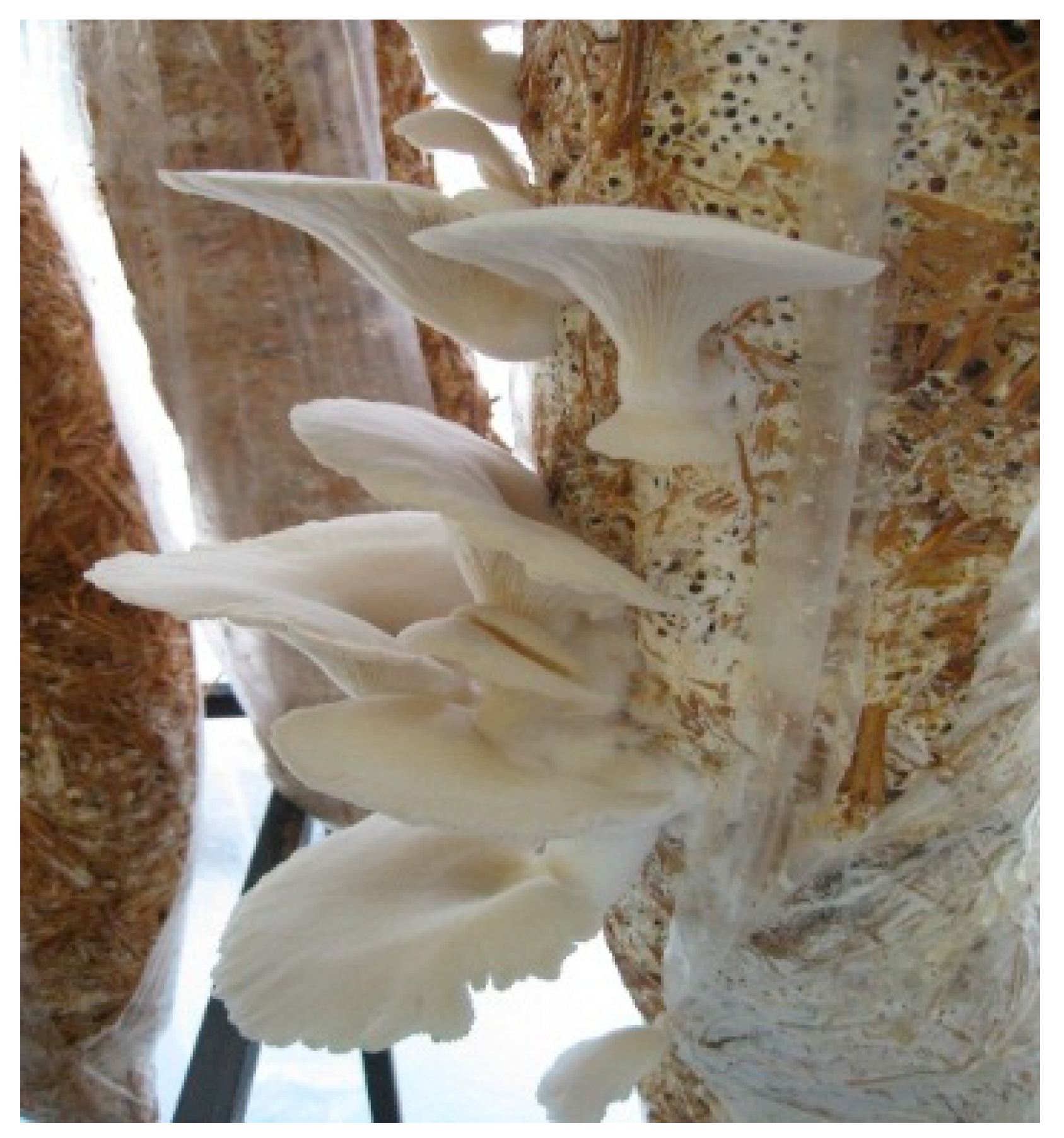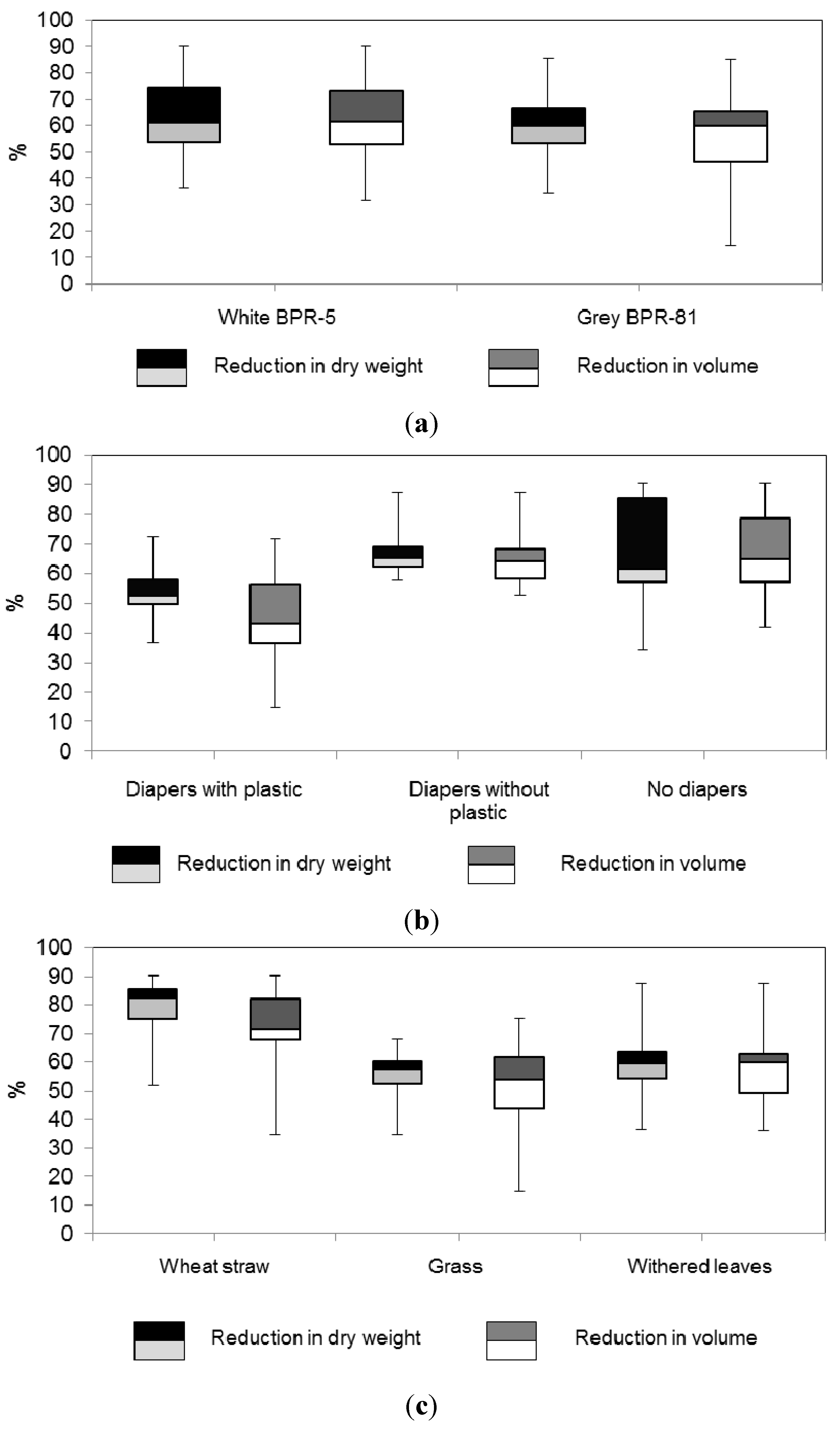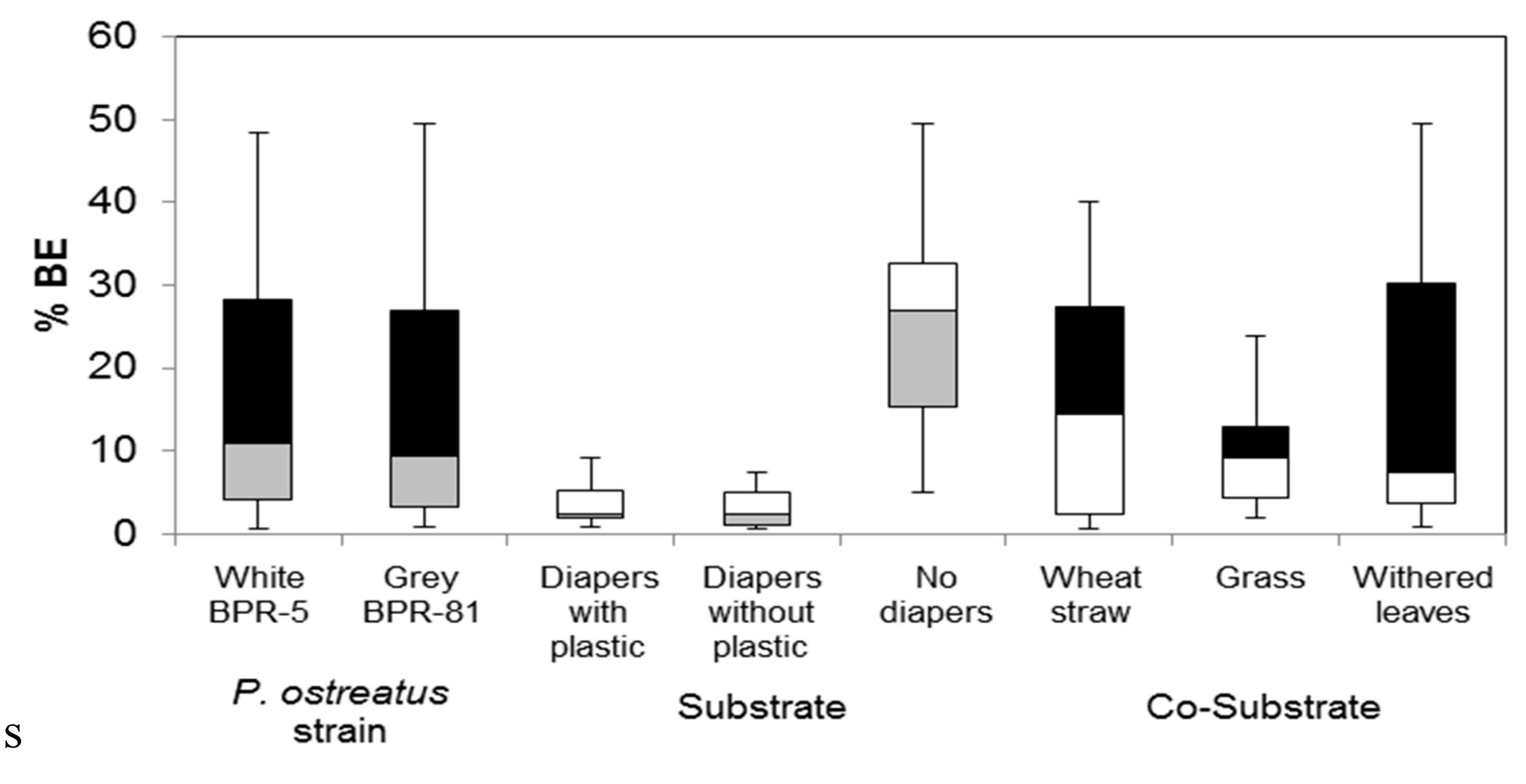Assessment of Gardening Wastes as a Co-Substrate for Diapers Degradation by the Fungus Pleurotus ostreatus
Abstract
:1. Introduction

| Substrate | Country | Reference |
|---|---|---|
| Rice straw and banana leaves | Brazil | [13] |
| Wood dust, wheat straw and leaves | Pakistan | [14] |
| Pine wood dust and barley straw | Mexico | [15] |
| Coffee pulp and wheat straw | Mexico | [16] |
| Populus chips, eucalyptus chips and wheat straw | Chile | [17] |
| Coffee pulp | Spain | [18] |
| Corn stubble, sorghum stubble and Bermuda grass | Mexico | [19] |
| Roselle plant, rice straw, banana leaves and stalks | Mexico | [20] |
| Wheat, millet, soy and cotton straw | Turkey | [21] |
| Olive leaves | Israel | [22] |
| Beet pulp, wood chips, palm, bran wheat, bran rice and soy | Iran | [23] |
| Wheat straw, baby diapers and grape pomace | Mexico | [11] |
| Wood dust, yucca skin, cotton waste and banana leaves | Nigeria | [24] |
| Garlic waste and corn waste | Argentina | [25] |
| Banana leaves, potato skin and sugarcane bagasse | Colombia | [26] |
| Wheat straw | Argentina | [27] |
| Goldenberries skin, pea skin, corncob and oat | Cuba—Ecuador | [28] |
| White bond paper and printed bond paper | Portugal | [29] |
2. Experimental Section
2.1. Determination of Baby Diapers Composition
2.2. Determination of Generation of Diaper Waste with Urine per Child
2.3. Biodegradation of Diapers by the Edible Fungus Pleurotus Ostreatus
2.3.1. Preparation of the Substrates
| Treatment | Conditioning of Substrate | Co-Substrate |
|---|---|---|
| 1 | Diapers with plastic | Wheat straw |
| 2 | Diapers with plastic | Grass |
| 3 | Diapers with plastic | Withered leaves |
| 4 | Diapers without plastic | Wheat straw |
| 5 | Diapers without plastic | Grass |
| 6 | Diapers without plastic | Withered leaves |
| 7 | Wheat straw | --- |
| 8 | Grass | --- |
| 9 | Withered leaves | --- |
2.3.2. Cultivation of Pleurotus Ostreatus

2.4. Evaluation of the Degradation Process
3. Results
3.1. Determination of Baby Diapers Composition

3.2. Determination of Generation of Diaper Waste with Urine per Child

3.3. Evaluation of the Degradation Process


4. Discussion
5. Conclusions
Acknowledgments
Author Contributions
Conflicts of Interest
References
- United States Census Bureau. US and World Populations Clock. Available online: http://www.census.gov/popclock/ (accessed on 25 February 2015).
- Cassidy, E.S.; West, P.J.; Gerber, J.S.; Foley, J.A. Redefining agricultural yields: From tonnes to people nourished per hectare. Environ. Res. Lett. 2013, 8, 1–9. [Google Scholar] [CrossRef]
- United Nations Environment Programme. Converting Waste Agricultural Biomass into a Resource, Compendium of Technologies; Shiga: Osaka, Japan, 2009. [Google Scholar]
- Colón, J.; Ruggieri, L.; Sámchez, A.; González, A.; Puig, I. Possibilities of composting disposable diapers with municipal solid waste. Waste Manag. Res. 2011, 29, 249–259. [Google Scholar] [CrossRef]
- Tello Espinosa, P.; Martínez Arce, E.; Daza, D.; Soulier Faure, M.; Terraza, H. Regional Evaluation on Urban Solid Waste Management in Latin America and the Caribbean 2010 Report. 2010. Available online: http://idbdocs.iadb.org/wsdocs/getdocument.aspx?docnum=36846537 (accessed on 12 May 2015).
- Blessed bums. Available online: http://www.blessedbums.com/ (accessed on 5 March 2015).
- Environcomp. Available online: http://www.envirocomopglobal.com (accessed on 5 March 2015).
- Knowaste. Available online: http://www.knowaste.com (accessed on 5 March 2015).
- Green Bin Organics Program Toronto. Available online: http://toronto.ca/greenbin/ (accessed on 5 March 2015).
- Colón, J.; Mestre-Montserrat, M.; Puig-Ventosa, I.; Sánchez, A. Performance of composteable baby used diapers in the composting process with the organic fraction of municipal solid waste. Waste Manag. 2013, 33, 1097–1103. [Google Scholar] [CrossRef] [PubMed]
- Espinosa-Valdemar, R.M.; Turpin-Marion, S.; Delfín-Alcalá, I.; Vazquez-Morillas, A. Disposable diapers biodegradation by the fungus Pleurotus Ostreatus. Waste Manag. 2011, 31, 1683–1688. [Google Scholar] [CrossRef] [PubMed]
- Zadrazil, F. Cultivation of Pleurotus. In The Biology and Cultivation of Edible Mushroom; Chang, S.T., Hayes, W.A., Eds.; Academic Press: New York, UY, USA, 1978; pp. 521–525. [Google Scholar]
- Bonatti, M.; Karnopp, P.; Soares, H.M.; Furlan, S.A. Evaluation of Pleurotus ostreatus and P. sajor-caju nutritional characteristics when cultivated on different lignocellulosic wastes. Food Chem. 2004, 88, 425–428. [Google Scholar] [CrossRef]
- Shah, Z.A.; Ashraf, M.; Ishtiaq-Ch, M. Comparative study on cultivation and yield performance of oyster mushroom (Pleurotus ostreatus) on different substrates (wheat straw, leaves, saw dust). Pak. J. Nutr. 2004, 3, 158–160. [Google Scholar] [CrossRef]
- Pérez, R.; Mata, G. Cultivo y selección de cepas de Pleurotus ostreatus y P. pulmonarius en viruta de pino: Obtención de nuevas cepas y evaluación de su producción. Revista Mexicana de Micología 2005, 20, 53–59. (In Spanish) [Google Scholar]
- Salmones, D.; Mata, G.; Waliszewski, K. Comparative culturing of Pleurotus sp. on coffee pulp and wheat straw; biomass production and substrate biodegradation. Bioresour. Technol. 2005, 96, 537–544. [Google Scholar] [CrossRef] [PubMed]
- Varnero, T.M.; Quiroz, M.S.; Álvarez, C.H. Utilización de residuos forestales lignocelulósicos para producción del hongo ostra (Pleurotus ostreatus). Información Tecnológica 2005, 21, 13–20. [Google Scholar] [CrossRef]
- García-Quiroga, F. Líneas de investigación y recursos bibliográficos sobre setas y hongos. Observatorio Medioambiental 2005, 8, 293–303. (In Spanish) [Google Scholar]
- Rodríguez, M.R.; González, G.R.; Ruiz, L.M.A.; García, L.P.M.; Ruiz, M.J.; Zamora, N.J.F.; Salcedo, P.E. Perspectivas de producción de hongos comestibles (Pleurotus spp.) en la región nordeste del Estado de Nuevo León. SCIENTIA-CUCBA 2006, 8, 162–169. (In Spanish) [Google Scholar]
- Cayetano-Catarino, M.; Bernabé-González, T. Cultivo de Pleurotus sobre residuos de las cosechas de Jamaica (Hibiscus sabdariffa) y plátano (Musa paradisiaca). Revista Mexicana de Micología 2008, 26, 57–60. (In Spanish) [Google Scholar]
- Dundar, A.; Acay, H.; Yildiz, A. Effect of using different lignocellulosic wastes for cultivation of Pleurotus ostreatus (Jacq.) P. Kumm. on mushroom yield, chemical composition and nutritional value. Afr. J. Biotechnol. 2009, 8, 662–666. [Google Scholar]
- Shabtay, A.; Hadar, Y.; Eitam, H.; Brosh, A.; Orlov, A.; Tadmor, Y. The potential of Pleurotus-treated olive mill solid waste as cattle feed. Bioresour. Technol. 2009, 100, 6457–6464. [Google Scholar] [CrossRef] [PubMed]
- Jafarpour, M.; Jalali Zand, A.; Dehdashtizadeh, B.; Sh, E.B. Evaluation of agricultural wastes and food complements usage on growth characteristics of Pleurotus ostreatus. Afr. J. Agri. Res. 2010, 5, 3291–3296. [Google Scholar] [CrossRef]
- Amuneke, E.H.; Dike, K.S.; Ogbulie, J.N. Cultivation of Pleurotus ostreatus: An edible mushroom from agro base waste products. J. Microbiol. Biotechnol. Res. 2011, 1, 1–14. [Google Scholar]
- Lechner, B.E.; Albertó, E. Search for new naturally occurring strains of Pleurotus to improve yields. Pleurotus albidus as a novel proposed species for mushroom production. Rev. Iberoam. Micol. 2011, 28, 148–154. [Google Scholar] [CrossRef]
- Sudiany, V.P.; Hoyos, J.L.; Mosquera, S.A. Uso de hojarasca de roble y bagazo de caña en la producción de Pleurotus ostreatus. Biotecnología en el Sector Agropecuario y Agroindustrial 2012, 10, 136–145. (In Spanish) [Google Scholar]
- Jaramillo, M.S.; Albertó, E. Heat treatment of wheat straw by immersion in hot water decreases mushroom yield in Pleurotus ostreatus. Rev Iberoam Micol. 2013, 30, 125–129. [Google Scholar] [CrossRef] [PubMed]
- Fernández-Rodríguez, F.; Ruilova-Cueva, M.B.; Hernández-Monzón, A. Programa para el diseño de mezclas de residuos agrícolas para el cultivo del hongo Pleurotus ostreatus. Tecnología Química 2014, XXXIV, 128–136. (In Spanish) [Google Scholar]
- Fernandes, Â.; Barros, L.; Martins, A.; Herbert, P.; Ferreira, I.C.F.R. Nutritional characterisation of Pleurotus ostreatus (Jacq. ex Fr.) P. Kumm. produced using paper scraps as substrate. Food Chem. 2014, 169, 396–400. [Google Scholar] [CrossRef] [PubMed]
- Santa Cruz-Navarro, D.; Espinosa-Valdemar, R.M.; Beltrán-Villavicencio, M.; Vázquez-Morillas, A.; Velasco-Pérez, M. Degradation of oxo-degradable-polyethylene and polylactic acid films embodied in the substrate of the edible fungus Pleurotus ostreatus. Nat. Resour. 2014, 5, 949–957. [Google Scholar] [CrossRef]
- Bautista, J.M.; Franco, B.L.; Martínez, S.G.; Gamiño, S.Z.; Ocaña, R. Valor nutritivo de setas (Pleurotus ostreatus) cultivadas en desechos de aguacate y piña. Acta Universitaria 1998, 7, 41–52. (In Spanish) [Google Scholar]
- López, C.; Hernández, R.; Suárez, C.; Borrero, M. Evaluación del crecimiento y producción de Pleurotus ostreatus sobre diferentes residuos agroindustriales del departamento de Cundinamarca. Universitas Scientiarum 2006, 13, 128–137. (In Spanish) [Google Scholar]
© 2015 by the authors; licensee MDPI, Basel, Switzerland. This article is an open access article distributed under the terms and conditions of the Creative Commons Attribution license (http://creativecommons.org/licenses/by/4.0/).
Share and Cite
Espinosa-Valdemar, R.M.; Vázquez-Morillas, A.; Ojeda-Benítez, S.; Arango-Escorcia, G.; Cabrera-Elizalde, S.; Quecholac-Piña, X.; Velasco-Pérez, M.; Sotelo-Navarro, P.X. Assessment of Gardening Wastes as a Co-Substrate for Diapers Degradation by the Fungus Pleurotus ostreatus. Sustainability 2015, 7, 6033-6045. https://doi.org/10.3390/su7056033
Espinosa-Valdemar RM, Vázquez-Morillas A, Ojeda-Benítez S, Arango-Escorcia G, Cabrera-Elizalde S, Quecholac-Piña X, Velasco-Pérez M, Sotelo-Navarro PX. Assessment of Gardening Wastes as a Co-Substrate for Diapers Degradation by the Fungus Pleurotus ostreatus. Sustainability. 2015; 7(5):6033-6045. https://doi.org/10.3390/su7056033
Chicago/Turabian StyleEspinosa-Valdemar, Rosa María, Alethia Vázquez-Morillas, Sara Ojeda-Benítez, Gabriela Arango-Escorcia, Sonia Cabrera-Elizalde, Xochitl Quecholac-Piña, Maribel Velasco-Pérez, and Perla X. Sotelo-Navarro. 2015. "Assessment of Gardening Wastes as a Co-Substrate for Diapers Degradation by the Fungus Pleurotus ostreatus" Sustainability 7, no. 5: 6033-6045. https://doi.org/10.3390/su7056033
APA StyleEspinosa-Valdemar, R. M., Vázquez-Morillas, A., Ojeda-Benítez, S., Arango-Escorcia, G., Cabrera-Elizalde, S., Quecholac-Piña, X., Velasco-Pérez, M., & Sotelo-Navarro, P. X. (2015). Assessment of Gardening Wastes as a Co-Substrate for Diapers Degradation by the Fungus Pleurotus ostreatus. Sustainability, 7(5), 6033-6045. https://doi.org/10.3390/su7056033






